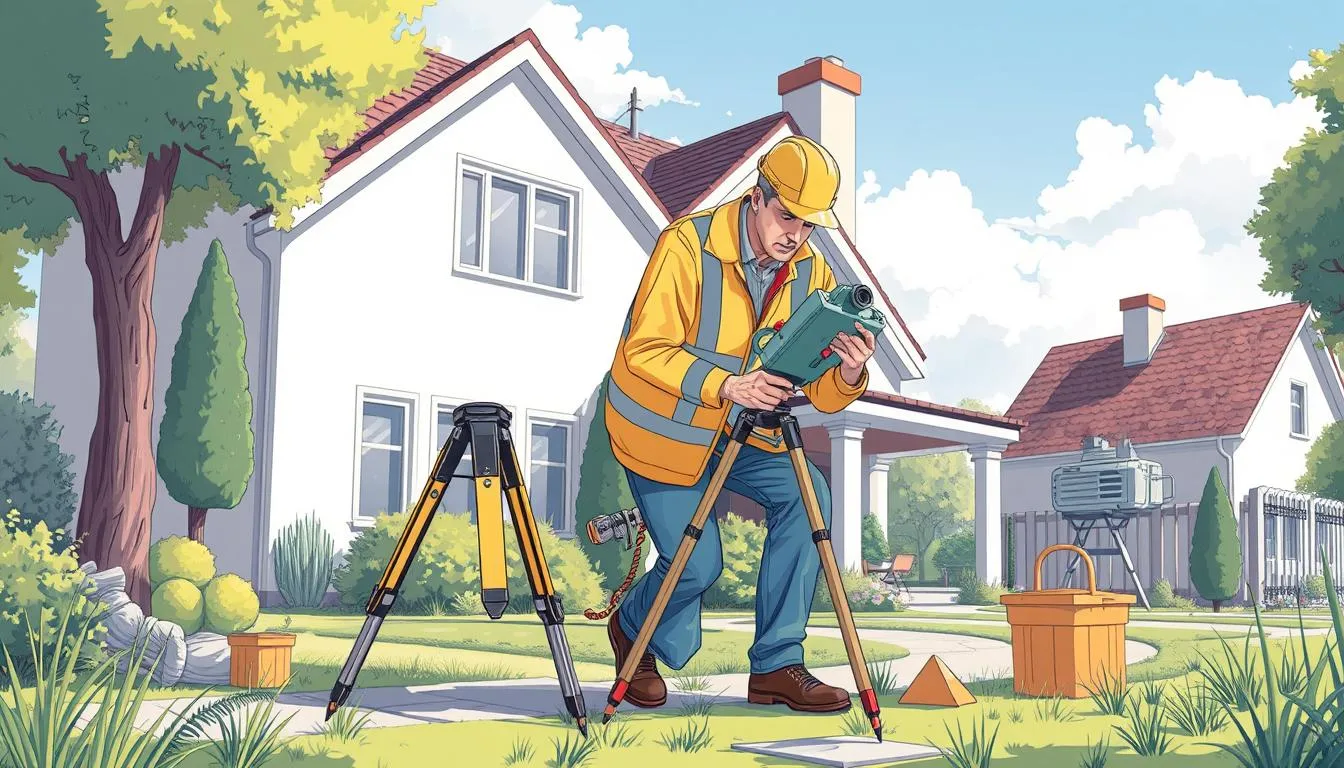When purchasing a property in the UK, it’s helpful to anticipate the duration of a homebuyers survey as part of your buying process.
A homebuyer’s survey is an inspection by a qualified surveyor of the condition of a property you plan to acquire. The surveyor will comment on structural issues or defects, providing you with a comprehensive report on the house condition.

The time taken to complete the survey varies depending on several factors, including the type of survey chosen, the size and age of the property, and its overall condition. A typical survey can take anywhere between 1-4 hours to complete, while a full structural house survey can take between 3-8 hours.
Key Points
- The duration of a homebuyers survey varies depending on the type of survey and property characteristics.
- A typical survey can take 1-4 hours to complete, while a full structural survey can take 3-8 hours.
- Understanding the survey duration is crucial for planning your property purchase timeline.
- A homebuyer’s survey helps identify potential issues before finalising your purchase.
- The surveyor will provide a comprehensive report on the property condition.
Understanding Homebuyers Surveys in the UK Property Market
The UK property market is known for its intricacies, and a homebuyers survey is a vital tool for prospective buyers because it is a comprehensive assessment of a property’s condition, providing buyers with important information about the building state.
What is a Homebuyers Survey?
A homebuyers survey is a detailed inspection of a property that evaluates its condition, highlighting any defects or potential issues. This type of survey is conducted by a qualified surveyor who assesses various aspects of the property, including its structure, dampness, and signs of infestation. The survey report provides a thorough overview of the property’s condition, helping buyers make informed decisions about the conveyancing.
Why Surveys Are Essential When Buying Property
Homebuyers surveys are essential protective measures that can save buyers from unexpected costs and stress after purchasing a property. A thorough house survey reveals hidden defects that aren’t visible during standard viewings, giving buyers a complete picture of the property’s true condition. The information provided in a home survey report allows buyers to make informed decisions about whether to proceed with the purchase, renegotiate the price, or request that the seller fixes certain issues before completion.
| Benefits of Homebuyers Surveys | Description |
|---|---|
| Reveals Hidden Defects | A thorough survey uncovers defects not visible during viewings. |
| Informed Decision Making | The survey report helps buyers decide whether to proceed or renegotiate. |
| Potential Cost Savings | Identifying issues early can save buyers from costly repairs. |
It’s crucial to ensure that the survey is undertaken before contracts have been exchanged and the offer is legally binding. This allows buyers to adjust their offer price or stipulate that the vendor must undertake remedial work to resolve any issues before the sale goes through.
Different Types of Homebuyers Surveys Available
Homebuyers in the UK have access to various survey options, each providing unique insights into a property’s condition. The Royal Institution of Chartered Surveyors (RICS) describes three main levels of surveys, catering to different property types and buyer needs.
Level 1: Condition Report
A Level 1 survey, also known as a Condition Report, provides a basic assessment of a property’s condition, highlighting any significant defects or issues. This report is ideal for modern, well-maintained properties, but is unsuitable for buying or selling real-estate as it lacks detail. A condition report is more applicable to Party Wall.

Level 2: Homebuyer Report
The Level 2 Homebuyer Report offers a more detailed evaluation of a property’s condition, including advice on repairs and maintenance. This survey is suitable for most residential properties and provides a comprehensive overview of the property.

Level 3: Building Survey
A Level 3 Building Survey, or Full Structural Survey, is the most comprehensive type of survey available. It is recommended for more expensive or older properties (typically over 50 years), those with unusual construction, or properties in a poor state of repair. This survey provides an in-depth analysis of the property’s condition, including guidance on defects, repairs, and maintenance. It is the best survey.

In summary, the type of survey a homebuyer chooses should be based on the property’s age, condition, and complexity. Understanding the different levels of surveys available can help buyers make informed decisions and potentially save on unexpected repair costs in the future.
How Long Does a Homebuyers Survey Take? Timeframes Explained
The duration of a homebuyers survey can vary significantly based on the type of survey chosen. Different surveys have different requirements and complexities, affecting the overall time needed to complete them.
Condition Report Duration: 1-2 Hours
A Condition Report is the most basic type of homebuyers survey, typically taking between 1 to 2 hours to complete. This survey provides a basic assessment of the property’s condition, highlighting any significant defects or issues. The relatively short duration is due to its limited scope, focusing on the most critical aspects of the property.
Homebuyer Report Duration: 1-4 Hours
A Homebuyer Report is more detailed than a Condition Report and usually takes between 1 to 4 hours to complete. This type of survey includes an inspection of the property’s condition, checking for defects, and providing advice on repairs or further investigations. The time required can vary depending on how big the property is.
Full Building Survey Duration: 3-8 Hours
A Full Building Survey, also known as a Full Structural Survey, is the most comprehensive type of homebuyers survey. It can take anywhere between 3 to 8 hours to complete, depending on the property’s size, age, and condition. This survey involves a detailed examination of the property’s structure and fabric, checking for defects, testing for damp, and examining the condition of timbers and other materials. For larger or more complex properties, the inspection may take a full day (6-8 hours) to complete thoroughly.
The extensive on-site inspection is followed by a detailed analysis and report preparation phase, which typically takes longer than other survey types, often 7-10 working days before you receive the final report.
- A Level 3 Building Survey is the most time-intensive type of homebuyers survey, typically taking between 3-8 hours to complete depending on the property.
- The extended duration reflects the comprehensive nature of this survey, which involves a detailed examination of all accessible parts of the property.
- For larger properties or those with unusual features, the inspection may take a full day to complete thoroughly.
Factors Affecting the Duration of Your Property Survey
The duration of a homebuyers survey is influenced by several key factors. Understanding these elements can help you better plan your home purchasing process.
Property Size and Complexity
The size and complexity of a property significantly impact the survey duration. Larger properties with multiple features, such as extensions or unique architectural designs, require more time to inspect thoroughly. For instance, a spacious house with several floors and numerous rooms will naturally take longer to survey than a smaller, more straightforward property.

Age and Condition of the Property
The condition and age of a property also play a crucial role in determining the survey time. Older properties or those in a state of disrepair may require more detailed inspections to identify potential issues, such as structural damage or outdated electrical systems. This can extend the overall duration of the survey.
Accessibility of Different Areas
The accessibility of various areas within a property can significantly affect how long a homebuyers survey takes. For example, restricted access to certain parts of the house, such as loft spaces or basements, can complicate the survey process. Surveyors may need to find alternative methods to assess these areas or use specialised equipment, thereby increasing the time required to complete the survey.
Moreover, occupied properties with limited access due to tenant possessions or furniture can also prolong the survey duration. Surveyors must work around these obstacles while conducting a thorough inspection, which can be time-consuming.
From Inspection to Report: The Complete Timeline
From the initial inspection to the final report, the timeline can differ based on several factors, including the type of survey and the surveyor’s workload. Understanding this timeline is essential for homebuyers to plan their property purchase effectively.

When to Expect Your Survey Report
The time taken to receive a survey report after the inspection varies depending on the survey type. For instance, a Condition Report typically takes 3-5 working days, while a Homebuyer Report may take 5-7 working days, and a Building Survey can take up to 7-12 working days.
Typical Waiting Times for Different Survey Types
Different surveys have different timelines. A Condition Report is usually completed within 1-2 hours of inspection, while a Homebuyer Report can take 1-4 hours. A Building Survey, being more comprehensive, can take anywhere from 3-8 hours. By booking directly with a surveyor, you can potentially reduce waiting times.
As a surveyor notes, “The key to a smooth process is direct communication and a clear understanding of the survey requirements.” Effective planning and choosing the right survey type can streamline the homebuying process.
Who Conducts Homebuyers Surveys and How to Choose a Surveyor
When buying a property in the UK, it’s crucial to understand who conducts homebuyers surveys and how to choose the right surveyor for your needs. A surveyor plays a vital role in the property buying process, providing you with a detailed report on the condition of the property.
Qualified Surveyors and Professional Bodies
In the UK, homebuyers surveys are typically conducted by qualified surveyors who are members of professional bodies such as the Royal Institution of Chartered Surveyors (RICS), Chartered Institute of Building (CIOB) or Residential Property Surveyors Association (RPSA). To find a qualified surveyor near you, who adheres to strict standards and codes of practice, contact us today.
Tips for Selecting the Right Surveyor
When selecting a surveyor for your home purchase, consider the following tips:
- Choose a surveyor with specific experience in the type of property you’re buying, especially for period properties or unusual constructions.
- Local surveyors often have better knowledge of regional property issues and construction methods.
- Discuss timeframes upfront with potential surveyors, especially if you’re working to a tight deadline.
By following these tips and choosing a qualified surveyor, you can ensure that your homebuyers survey is conducted efficiently and effectively, providing you with the information you need to make an informed decision about your property purchase.
Conclusion: Planning Your Home Purchase Timeline
Understanding the duration and significance of a homebuyers survey can help buyers plan their property purchase timeline effectively. When buying a property, it’s essential to factor in the time required for the survey and report delivery before exchanging contracts.
A homebuyers survey is different from a mortgage valuation, which is conducted for the lender’s benefit. The former survey provides buyers with valuable insights into the property condition, helping them make informed decisions.
For most property purchases, allowing approximately 2-3 weeks from instructing a surveyor to receiving the final report is recommended. This timeframe enables buyers to address any issues identified in the survey without feeling pressured.
By investing time and money in a comprehensive house survey, buyers can avoid costly surprises and ensure a smoother purchase process.
FAQ
What is the purpose of a homebuyers survey?
The primary purpose of a homebuyers survey is to provide an independent assessment of the property’s condition, highlighting any defects or potential issues that may impact its value or require costly repairs.
What are the different types of homebuyers surveys available?
There are three main types of surveys: Level 1 – Condition Report, Level 2 – Homebuyer Report, and Level 3 – Building Survey (Full Structural Survey), each offering varying levels of detail and inspection.
How do I choose the right surveyor for my homebuyers survey?
To select the right surveyor, look for professionals accredited to reputable bodies such as the Royal Institution of Chartered Surveyors (RICS), Chartered Institute of Building (CIOB) or Residential Property Surveyors Association (RPSA), and consider their experience, expertise, and reviews from previous clients.
What factors can affect the duration of a homebuyers survey?
The time taken to complete a survey can be influenced by factors such as the property’s size, age, condition, and complexity, as well as the surveyor’s level of experience and the level of detail required.
What is the typical waiting time for a survey report after the inspection?
The waiting time for a survey report can vary depending on the survey type and the surveyor’s workload, but typically ranges from a few days to a week or more for more complex surveys.
Can a homebuyers survey help me negotiate the property’s purchase price?
Yes, a homebuyers survey can provide valuable evidence of any defects or issues, which can be used to negotiate a more favourable purchase price or request repairs from the seller.
Are homebuyers surveys a requirement for obtaining a mortgage?
While not always mandatory, lenders often require a mortgage valuation survey to ensure the property’s value secures the loan; however, a more comprehensive homebuyers survey is highly recommended to protect the buyer’s interests.





